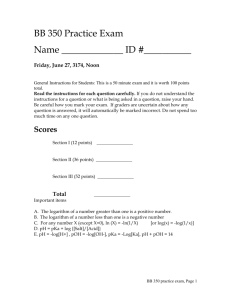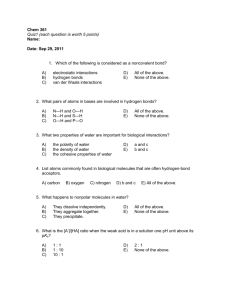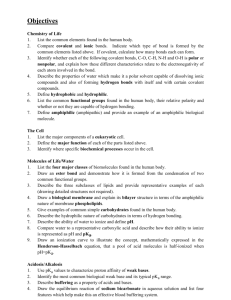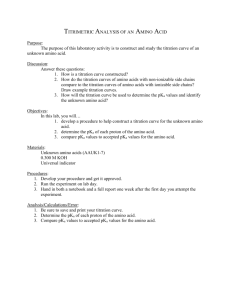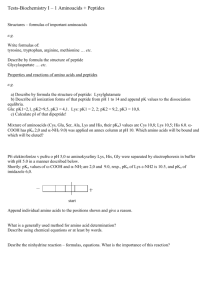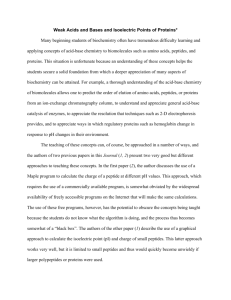Ch03Pt1
advertisement
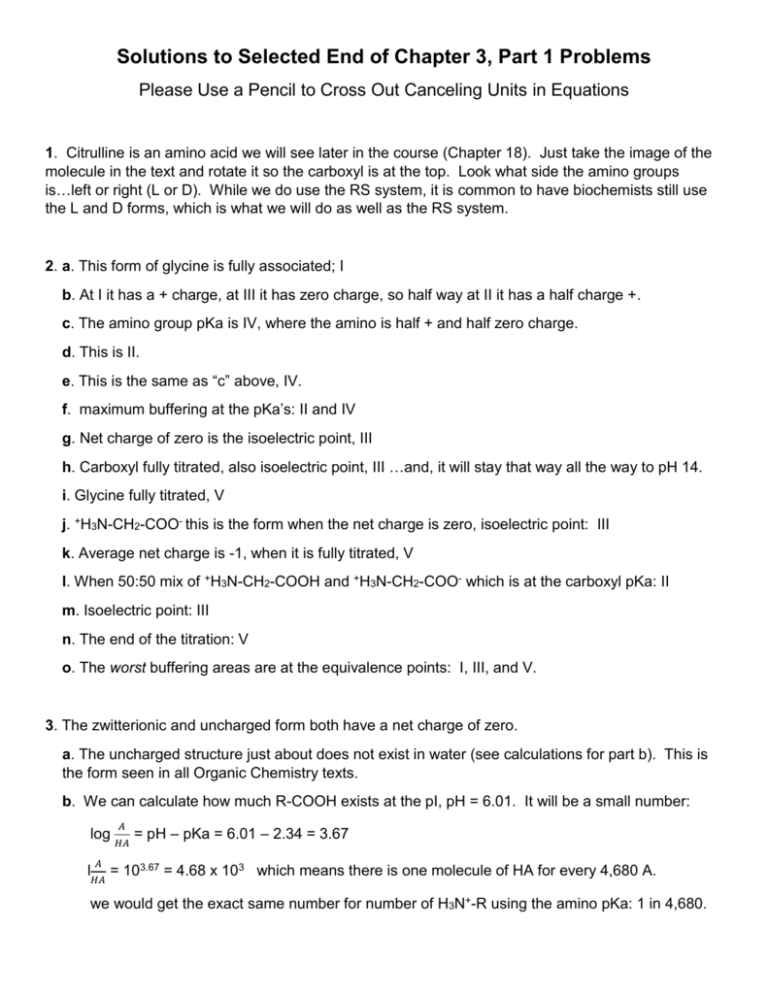
Solutions to Selected End of Chapter 3, Part 1 Problems Please Use a Pencil to Cross Out Canceling Units in Equations 1. Citrulline is an amino acid we will see later in the course (Chapter 18). Just take the image of the molecule in the text and rotate it so the carboxyl is at the top. Look what side the amino groups is…left or right (L or D). While we do use the RS system, it is common to have biochemists still use the L and D forms, which is what we will do as well as the RS system. 2. a. This form of glycine is fully associated; I b. At I it has a + charge, at III it has zero charge, so half way at II it has a half charge +. c. The amino group pKa is IV, where the amino is half + and half zero charge. d. This is II. e. This is the same as “c” above, IV. f. maximum buffering at the pKa’s: II and IV g. Net charge of zero is the isoelectric point, III h. Carboxyl fully titrated, also isoelectric point, III …and, it will stay that way all the way to pH 14. i. Glycine fully titrated, V j. +H3N-CH2-COO- this is the form when the net charge is zero, isoelectric point: III k. Average net charge is -1, when it is fully titrated, V l. When 50:50 mix of +H3N-CH2-COOH and +H3N-CH2-COO- which is at the carboxyl pKa: II m. Isoelectric point: III n. The end of the titration: V o. The worst buffering areas are at the equivalence points: I, III, and V. 3. The zwitterionic and uncharged form both have a net charge of zero. a. The uncharged structure just about does not exist in water (see calculations for part b). This is the form seen in all Organic Chemistry texts. b. We can calculate how much R-COOH exists at the pI, pH = 6.01. It will be a small number: 𝐴 log 𝐻𝐴 = pH – pKa = 6.01 – 2.34 = 3.67 𝐴 l𝐻𝐴 = 103.67 = 4.68 x 103 which means there is one molecule of HA for every 4,680 A. we would get the exact same number for number of H3N+-R using the amino pKa: 1 in 4,680. The chance we would get both on the same molecule is 1 to 4,680 x 4,680 = 2.19 x 107 which means only one in 21.9 million molecules would be fully uncharged. And, it wouldn’t last long! 4. Ionization and charge state of Histidine. a and b: . These are the structures at the equivalence points. Charges: 1 = +2. 2 = +1. 3 = 0. 4 = -1. c. Migration in an electric field: cathode has a – charge, and anode has a + charge. So structures 1 and 2 would migrate toward the cathode, 3 wouldn’t move, 4 would move toward the anode. 5. Separation of amino acids on a sulfonate group attached to a non-polar resin. At pH 7 the resin has a negative charge due to the sulfonate group so it would attract and hold back cations, as well as the resin itself will attract hydrophobic (non polar) amino acids. a. asp, lys at pH 7 D will have a negative charge and K will have a positive charge. Asp will come out first followed by lys held back by the negatively charged resin. b. arg, met at pH 7 R has a positive charge and met has no charge. Met would come off first, followed by arg. c. glu, val at pH 7 E has a negative charge and V has just about no charge. So E will come off first followed by V. d. gly, leu at pH 7 they have very similar almost no charge. L is more hydrophobic than G, so L will come off last. e. ser, ala at pH 7 both have just about a zero charge. But ser has a non-charged polar group whereas ala has a methyl, non polar group and thus ala will come off last. 6. Leucine has two chiral carbons (at carbons 2 and 3). Check out the figure, it is pretty obvious. a, two at carbons 2 and 3. b. there are four sterioisomers (S,S, R,R, S,R and R,S) c. these are easy to draw: basic Orgo 1. 7. This is a fun problem demonstrating the closeness of the amino group to the pKa of the carboxyl and the reciprocal effect of the closeness of the carboxyl on the pKa of the amino group in peptides made only from ala. The table data: Amino Acid or Peptide Ala Ala-Ala Ala-Ala-Ala Ala-Ala-Ala-Ala pKa1 2.34 3.12 3.39 3.42 pKa2 9.69 8.30 8.03 7.94 a. Drawing these, it is readily apparent that the only weak acid groups are the C-terminal carboxyl group and the N-terminal amino group. All the other carboxyls and aminos are used to form the peptide bond that hold these amino acids together to form peptides and proteins. b. The pKa1 increased because the farther the amino group was away, the carboxyl became weaker and weaker (increase its pKa value) c. The negative charge of the carboxyl made the weak acid, amino group, even weaker and raised its pKa. The farther away the carboxyl is, the stronger a weak acid the amino group became, thus lowering the pKa.
